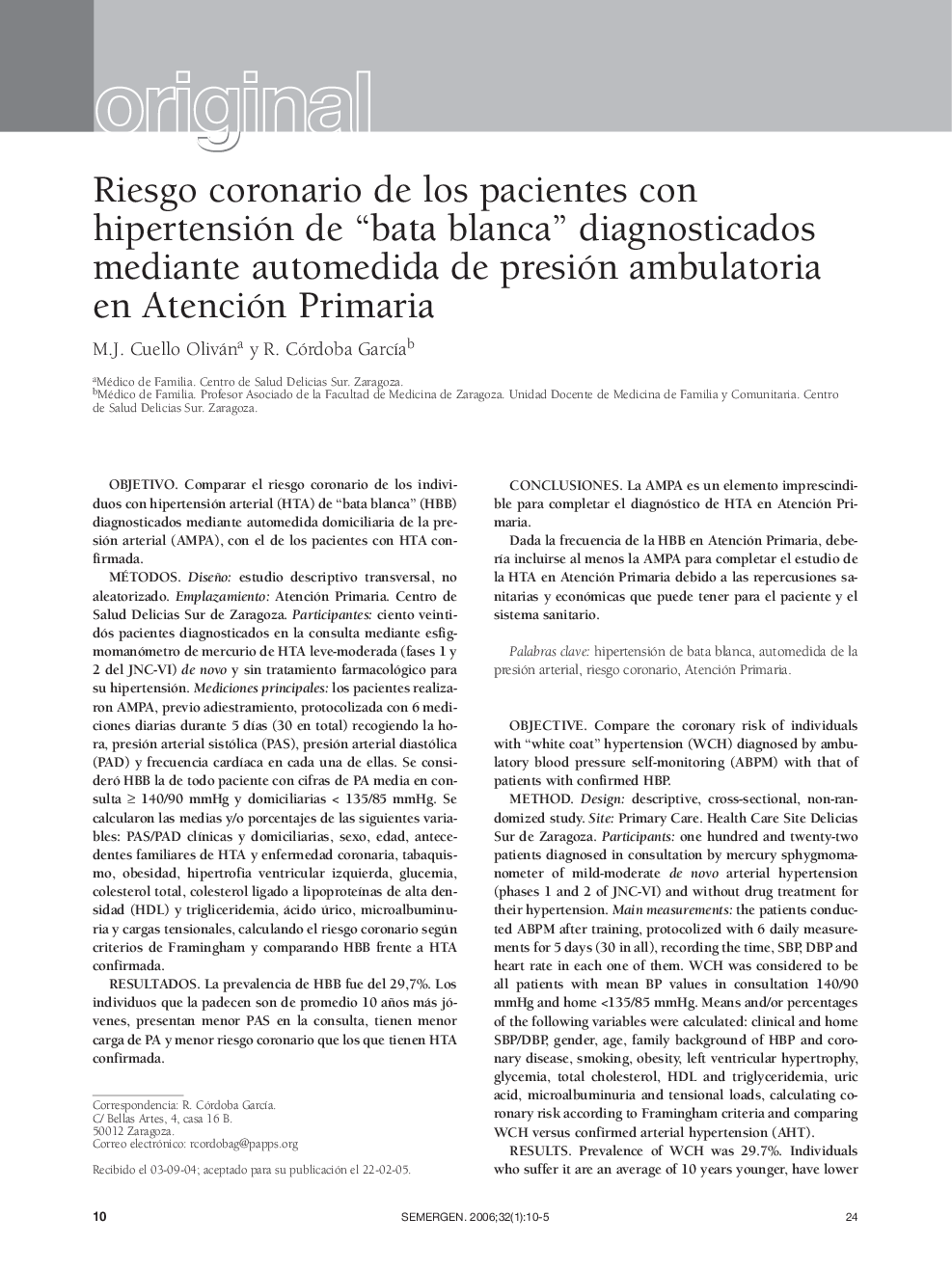| Article ID | Journal | Published Year | Pages | File Type |
|---|---|---|---|---|
| 3835501 | SEMERGEN - Medicina de Familia | 2006 | 6 Pages |
ObjetivoComparar el riesgo coronario de los individuos con hipertensión arterial (HTA) de “bata blanca” (HBB) diagnosticados mediante automedida domiciliaria de la presión arterial (AMPA), con el de los pacientes con HTA confirmada.MétodosDiseño: estudio descriptivo transversal, no aleatorizado. Emplazamiento: Atención Primaria. Centro de Salud Delicias Sur de Zaragoza. Participantes: ciento veintidós pacientes diagnosticados en la consulta mediante esfigmomanómetro de mercurio de HTA leve-moderada (fases 1 y 2 del JNC-VI) de novo y sin tratamiento farmacológico para su hipertensión. Mediciones principales: los pacientes realizaron AMPA, previo adiestramiento, protocolizada con 6 mediciones diarias durante 5 dÃas (30 en total) recogiendo la hora, presión arterial sistólica (PAS), presión arterial diastólica (PAD) y frecuencia cardÃaca en cada una de ellas. Se consideró HBB la de todo paciente con cifras de PA media en consulta ⥠140/90 mmHg y domiciliarias < 135/85 mmHg. Se calcularon las medias y/o porcentajes de las siguientes variables: PAS/PAD clÃnicas y domiciliarias, sexo, edad, antecedentes familiares de HTA y enfermedad coronaria, tabaquismo, obesidad, hipertrofia ventricular izquierda, glucemia, colesterol total, colesterol ligado a lipoproteÃnas de alta densidad (HDL) y trigliceridemia, ácido úrico, microalbuminuria y cargas tensionales, calculando el riesgo coronario según criterios de Framingham y comparando HBB frente a HTA confirmada.ResultadosLa prevalencia de HBB fue del 29,7%. Los individuos que la padecen son de promedio 10 años más jóvenes, presentan menor PAS en la consulta, tienen menor carga de PA y menor riesgo coronario que los que tienen HTA confirmada.ConclusionesLa AMPA es un elemento imprescindible para completar el diagnóstico de HTA en Atención Primaria.Dada la frecuencia de la HBB en Atención Primaria, deberÃa incluirse al menos la AMPA para completar el estudio de la HTA en Atención Primaria debido a las repercusiones sanitarias y económicas que puede tener para el paciente y el sistema sanitario.
ObjectiveCompare the coronary risk of individuals with “white coat” hypertension (WCH) diagnosed by ambulatory blood pressure self-monitoring (ABPM) with that of patients with confirmed HBP.MethodDesign: descriptive, cross-sectional, non-randomized study. Site: Primary Care. Health Care Site Delicias Sur de Zaragoza. Participants: one hundred and twenty-two patients diagnosed in consultation by mercury sphygmomanometer of mild-moderate de novo arterial hypertension (phases 1 and 2 of JNC-VI) and without drug treatment for their hypertension. Main measurements: the patients conducted ABPM after training, protocolized with 6 daily measurements for 5 days (30 in all), recording the time, SBP, DBP and heart rate in each one of them. WCH was considered to be all patients with mean BP values in consultation 140/90 mmHg and home <135/85 mmHg. Means and/or percentages of the following variables were calculated: clinical and home SBP/DBP, gender, age, family background of HBP and coronary disease, smoking, obesity, left ventricular hypertrophy, glycemia, total cholesterol, HDL and triglyceridemia, uric acid, microalbuminuria and tensional loads, calculating coronary risk according to Framingham criteria and comparing WCH versus confirmed arterial hypertension (AHT).ResultsPrevalence of WCH was 29.7%. Individuals who suffer it are an average of 10 years younger, have lower SPB in the consultation, have less BP load and less coronary risk than those who have confirmed AHT.ConclusionsABPM is an essential element to complete AHT diagnosis in Primary Care. Given the frequency of WCH in Primary Care, ABPM should at least be included to complete the AHT study in Primary Care due to the health care and economic repercussions that it may have for the patient and health care system.
